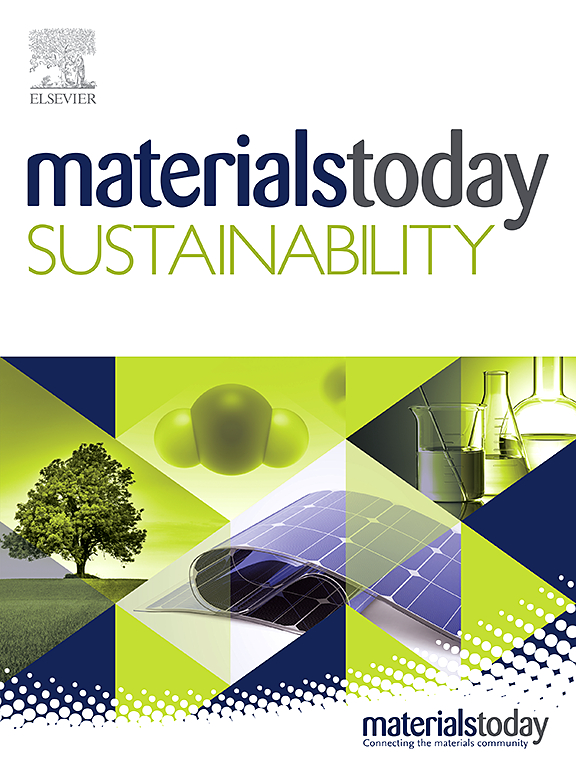嵌入纳米颗粒丝素水凝胶作为表面增强拉曼散射(SERS)底物检测水中亚甲基蓝
IF 7.9
3区 材料科学
Q1 GREEN & SUSTAINABLE SCIENCE & TECHNOLOGY
引用次数: 0
摘要
表面增强拉曼散射(SERS)是一种强大而有吸引力的分析检测技术,它能够通过共振和电荷转移效应放大等离子体金属纳米颗粒表面附近或表面的目标分子的拉曼信号。丝素蛋白(SF)是一种从家蚕蚕茧中提取的蛋白质,由于易于加工和可加工成不同的材料形状以承载SERS活性材料,因此引起了人们对用作SERS基质的兴趣。制备了水稳定等离子体纳米粒子(Nps),即:Au和Ag,以及通过Lee Meisel协议合成的另一种形式的Ag纳米粒子(此处称为Ag *),并通过透射电子显微镜、动态光散射和紫外可见光谱对其进行了表征。首先,以亚甲基蓝(MB)为模型有机污染物,在悬浮液中进行Nps的SERS检测活性测试。然后通过先前开发的酶交联方法制备SF-AuNp, SF-AgNp, SF-AgNps *水凝胶。利用扫描电镜(SEM)、红外光谱(FTIR)和紫外可见光谱(UV-vis)对Nps水凝胶进行表征。然后将MB上的SERS检测活性扩展到含有Nps的水凝胶。在785 nm激发下对MB分析物进行SERS测试,Au-Nps、AgNps、AgNps∗悬浮液分别达到1.56 μM、15.63 μM和15.63 μM的浓度检测水平,而SF-AuNps、SF-AgNps和SF-AgNps∗水凝胶的SERS活性性能评价分别达到0.27 μM、0.27 μM和0.17 μM。从总体上看,性能最好的SF-AgNps∗在测试的Nps悬浮液中具有约7.4的信号放大因子,对于测试的SF-AgNps∗水凝胶材料实现了超过400的信号放大,与在溶液中测试的Nps相比,获得的增强几乎是60倍。与悬浮液试验相比,SF-Nps水凝胶的固有吸附能力,通过SF-Nps水凝胶基质对MB的浓度进行检测,代表了开发高效环境检测系统的一个有前途的策略。本文章由计算机程序翻译,如有差异,请以英文原文为准。
Embedded nanoparticle silk fibroin hydrogel as surface enhanced Raman scattering (SERS) substrates for detection of methylene blue in water
Surface Enhanced Raman Scattering (SERS) is a powerful and attractive analytical detection technique capable of amplifying Raman signal of target molecules near or at the surface of plasmonic metal nanoparticles due to resonance and charge transfer effect. Silk fibroin (SF), a protein extracted from Bombyx mori cocoon has stirred interest for use as a SERS matrix due to ease of processing and workability into different material shapes for hosting SERS active materials. Water stabilized plasmonic nanoparticles (Nps) namely: Au, and Ag synthesized by facile green procedure and another synthesized form of Ag nanoparticles via Lee Meisel protocol (referred to here as Ag∗) were prepared, and characterized by transmission electron microscopy, dynamic light scattering, and UV–visible spectroscopy. Firstly, SERS detection activity tests of the Nps were performed in suspension over methylene blue (MB) as the model organic pollutant. The SF-AuNp, SF-AgNp, SF-AgNps∗ hydrogels were then prepared by previously developed enzyme cross-linking methodology. SEM, FTIR, and UV–vis spectroscopy were used to characterize the Nps containing hydrogels. SERS detection activity over MB was then extended to hydrogels containing Nps. Executed SERS test over MB analyte and under 785 nm excitation recorded 1.56 μM, 15.63 μM, and 15.63 μM respectively as concentration detection levels reached with Au-Nps, AgNps, AgNps∗ suspensions, while 0.27 μM, 0.27 μM, and 0.17 μM were respectively achieved in the case of SF-AuNps, SF-AgNps, and SF-AgNps∗ hydrogels SERS activity performance evaluation. From a general look, the best performing SF-AgNps∗ with a signal amplification factor of about 7.4 for tested Nps suspension, achieved over 400 signal amplification for the tested SF-AgNps∗ hydrogel material representing almost 60 times fold of enhancement obtained in comparison to Nps tested in solution. The inherent adsorption capability of the SF-Nps hydrogels in comparison to the suspension test, facilitated through the concentration of MB by the SF-Nps hydrogels matrix for detection, represents a promising strategy in the development of efficient environmental detection systems.
求助全文
通过发布文献求助,成功后即可免费获取论文全文。
去求助
来源期刊

Materials Today Sustainability
Multiple-
CiteScore
5.80
自引率
6.40%
发文量
174
审稿时长
32 days
期刊介绍:
Materials Today Sustainability is a multi-disciplinary journal covering all aspects of sustainability through materials science.
With a rapidly increasing population with growing demands, materials science has emerged as a critical discipline toward protecting of the environment and ensuring the long term survival of future generations.
 求助内容:
求助内容: 应助结果提醒方式:
应助结果提醒方式:


